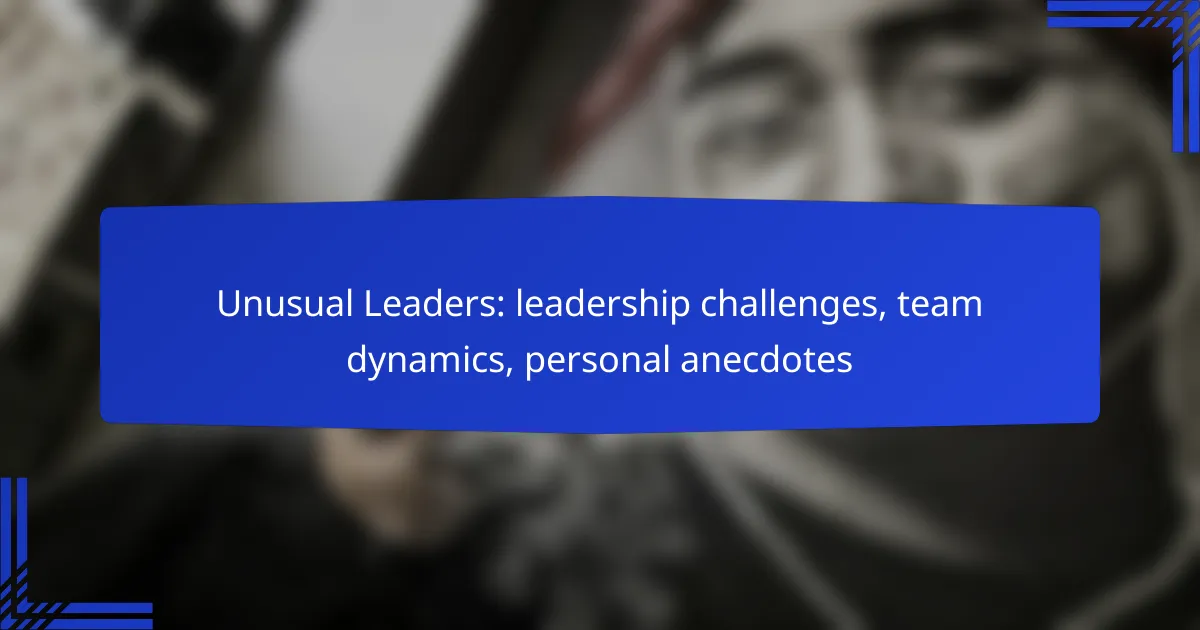Unusual leaders face distinct challenges due to their non-traditional methods, often encountering resistance and complex team dynamics. By leveraging their unique perspectives and fostering inclusivity, they can cultivate a collaborative environment that embraces diversity. Personal anecdotes from these leaders highlight the intricacies of navigating interpersonal conflicts and decision-making, offering valuable insights into resilience and effective communication.

What leadership challenges do unusual leaders face in Canada?
Unusual leaders in Canada often encounter unique challenges that stem from their non-traditional approaches. These challenges can include resistance from team members, the need to manage diverse dynamics, and navigating complex organizational politics.
Resistance to unconventional methods
Unusual leaders frequently face skepticism when implementing innovative strategies. Team members accustomed to traditional methods may resist change, fearing disruption or uncertainty. To overcome this, leaders should communicate the benefits of their approaches clearly and involve team members in the decision-making process.
Building trust is essential; leaders can achieve this by sharing success stories from similar contexts or industries. Engaging team members through workshops or brainstorming sessions can also help in easing resistance and fostering a collaborative environment.
Balancing diverse team dynamics
Diverse teams bring a wealth of perspectives but can also lead to conflicts if not managed effectively. Unusual leaders must be adept at recognizing and valuing these differences while promoting a cohesive team culture. Establishing clear communication channels and encouraging open dialogue can help mitigate misunderstandings.
Leaders should also consider implementing team-building activities that celebrate diversity and foster inclusivity. Regular check-ins can help gauge team morale and address any emerging issues before they escalate.
Navigating organizational politics
Unusual leaders often find themselves in complex political landscapes within organizations. They must skillfully navigate relationships with stakeholders who may have differing agendas. Understanding the power dynamics at play is crucial for gaining support and influencing decisions.
Building alliances with key influencers can provide valuable backing for unconventional initiatives. Leaders should also be prepared to advocate for their vision while remaining adaptable to feedback and changes in the organizational climate.

How can unusual leaders overcome team dynamics issues?
Unusual leaders can effectively address team dynamics issues by embracing their unique perspectives and fostering an inclusive environment. By prioritizing open communication, collaboration, and conflict resolution, these leaders can create a cohesive team that thrives on diversity.
Fostering open communication
Open communication is essential for unusual leaders to understand their team’s dynamics. Leaders should encourage team members to express their thoughts and feelings without fear of judgment. Regular check-ins and feedback sessions can help create a safe space for dialogue.
Utilizing tools such as anonymous surveys or suggestion boxes can further promote candidness. This approach allows leaders to gauge team sentiments and address concerns proactively, ensuring everyone feels heard and valued.
Encouraging collaboration
Collaboration among team members enhances creativity and problem-solving. Unusual leaders can facilitate this by organizing team-building activities that promote trust and camaraderie. These activities can range from brainstorming sessions to collaborative projects that leverage individual strengths.
Additionally, leaders should establish clear roles and responsibilities within the team to ensure everyone knows how they contribute to collective goals. This clarity helps minimize misunderstandings and fosters a sense of ownership among team members.
Implementing conflict resolution strategies
Conflict is inevitable in any team, but unusual leaders can manage it effectively by implementing structured resolution strategies. Encouraging open discussions about conflicts can help address issues before they escalate. Leaders should guide these conversations to ensure they remain constructive.
Additionally, providing training on conflict resolution techniques can empower team members to handle disputes independently. Techniques such as active listening and empathy can be valuable tools in resolving disagreements and maintaining a positive team dynamic.

What personal anecdotes illustrate leadership challenges?
Personal anecdotes often reveal the complexities of leadership challenges, showcasing how leaders navigate team dynamics, decision-making, and interpersonal conflicts. These stories provide valuable lessons on resilience, adaptability, and the importance of communication in overcoming obstacles.
Case study of a tech startup founder
A tech startup founder faced significant leadership challenges when the company pivoted its business model. Initially, the team was resistant to change, fearing instability and loss of direction. The founder organized open forums to discuss concerns, encouraging team members to share their thoughts and ideas, which fostered a sense of ownership and collaboration.
This approach not only helped in addressing the team’s fears but also led to innovative solutions that improved the product. The founder learned that transparent communication and involving the team in decision-making are crucial in overcoming resistance during significant changes.
Insights from a non-profit organization director
A director of a non-profit organization encountered leadership challenges when funding cuts threatened key programs. To address this, the director held a series of strategy sessions with staff and stakeholders to brainstorm alternative funding sources and program adjustments. This collaborative effort not only generated new ideas but also strengthened team cohesion.
The director emphasized the importance of adaptability and creative problem-solving in leadership. By engaging the team in the process, the director was able to maintain morale and focus on the mission, demonstrating that challenges can be transformed into opportunities through collective effort and innovation.

What frameworks support unusual leadership styles?
Unusual leadership styles can be effectively supported by frameworks that emphasize adaptability and inspiration. Two prominent models are transformational leadership and situational leadership, each offering unique strategies to navigate team dynamics and challenges.
Transformational leadership model
The transformational leadership model focuses on inspiring and motivating team members to exceed their own self-interests for the sake of the group. Leaders using this approach foster an environment of trust and innovation, encouraging team members to take ownership of their roles.
Key components include establishing a compelling vision, promoting intellectual stimulation, and providing individualized support. For instance, a leader might share a bold vision for a project and encourage team members to brainstorm creative solutions, thus enhancing engagement and commitment.
To implement this model, leaders should regularly communicate their vision and recognize individual contributions. Avoid micromanaging, as it can stifle creativity and diminish motivation.
Situational leadership approach
The situational leadership approach emphasizes the need for leaders to adjust their style based on the team’s maturity and the specific context. This flexibility allows leaders to provide the right level of guidance and support, adapting their methods to meet varying team needs.
Leaders assess team members’ competence and confidence, then choose from directing, coaching, supporting, or delegating styles. For example, a new team member may require more direction, while an experienced employee might thrive with a delegating approach.
To effectively apply this model, leaders should regularly evaluate team dynamics and be willing to shift their leadership style as circumstances change. Avoid rigid adherence to one style, as this can lead to disengagement or confusion among team members.

How do cultural factors influence leadership in Canada?
Cultural factors significantly shape leadership styles and practices in Canada, emphasizing values such as collaboration, respect, and inclusivity. Leaders must navigate a diverse landscape that reflects the country’s multicultural fabric, which impacts team dynamics and decision-making processes.
Diversity and inclusion in leadership
Diversity and inclusion are central to effective leadership in Canada, as they foster innovation and enhance team performance. Leaders are encouraged to create environments where different perspectives are valued, which can lead to more creative solutions and improved employee engagement.
To promote diversity, leaders should actively seek to recruit from a wide range of backgrounds and ensure that all voices are heard in discussions. This can involve implementing mentorship programs and providing training on unconscious bias to help teams work more effectively together.
Regional leadership styles across Canada
Leadership styles in Canada can vary significantly by region, influenced by local cultures and demographics. For example, leaders in urban areas like Toronto may adopt a more fast-paced, results-oriented approach, while those in rural regions might prioritize relationship-building and community engagement.
Understanding these regional differences is crucial for leaders who operate across multiple provinces. They should adapt their strategies to align with local expectations, which may include being more formal in some areas and more casual in others. This adaptability can enhance trust and cooperation within diverse teams.

What are the emerging trends in leadership?
Emerging trends in leadership focus on adaptability, emotional intelligence, and remote team dynamics. Leaders are increasingly required to navigate complex environments while fostering collaboration and understanding within diverse teams.
Remote leadership effectiveness
Remote leadership effectiveness hinges on clear communication and trust-building. Leaders must leverage digital tools to maintain engagement and ensure that team members feel connected despite physical distances.
To enhance effectiveness, leaders should establish regular check-ins and utilize video conferencing for more personal interactions. Setting clear expectations and providing timely feedback are crucial for maintaining productivity in remote settings.
Emphasis on emotional intelligence
The emphasis on emotional intelligence in leadership is growing, as it plays a key role in team dynamics and conflict resolution. Leaders who demonstrate empathy and self-awareness can better understand their team members’ needs and motivations.
To cultivate emotional intelligence, leaders should practice active listening and seek feedback from their teams. Training programs focused on emotional skills can also be beneficial, helping leaders navigate interpersonal relationships and foster a positive work environment.

How can unusual leaders prepare for future challenges?
Unusual leaders can prepare for future challenges by embracing flexibility and fostering a culture of innovation within their teams. This involves continuously learning from experiences and adapting strategies to meet evolving demands.
Continuous learning and adaptation
Continuous learning and adaptation are crucial for unusual leaders facing future challenges. This approach encourages leaders to stay informed about industry trends, emerging technologies, and shifts in team dynamics. By actively seeking knowledge, they can make informed decisions that benefit their organizations.
Leaders should consider implementing regular training sessions and workshops for themselves and their teams. These can range from skill development to exploring new methodologies that enhance productivity. For example, a quarterly workshop on agile project management can help teams respond more effectively to changing project requirements.
To foster a culture of continuous learning, leaders should promote open communication and feedback. Encouraging team members to share insights and lessons learned from both successes and failures can create a supportive environment that values growth. This can be as simple as a monthly team meeting dedicated to discussing recent challenges and solutions.
